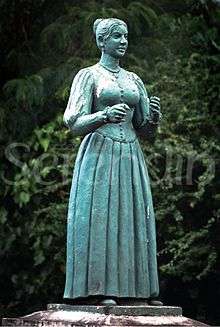Gajaman Nona
Donna Isabella Koraneliya (Sinhala:දෝන ඉසබෙලා කොරනෙලියා) (a.k.a. Gajaman Nona) (10 March 1746-15 December 1815) was a Ceylonese author who was noted for having the ability to write and recite impromptu Sinhala poetry. She was born in Col, Ceylon as the second daughter of Don Francisco Senarathna Kumara Perumal and Francina Jasenthu Graivo.[1] Gajaman was baptised as Donna Isabella Koraneliya. She had her early education within her own family.[2] She was talented and earned her honorific name Gajaman Nona (Lady Gajaman) from her mother. She grew up in Matara,[3] with a taste for dressing like a Dutch woman, which came from her partially 'Westernized' background.[4] She had a surprising talent in literature, which was highlighted by the women of her community and status.
Gajaman Nona | |
|---|---|
 Gajaman Nona's Statue Situated at Nonagama Junction, Ambalantota | |
| Born | Donna Isabella Koraneliya 10 March 1746 |
| Died | 15 December 1815 (aged 69) Ceylon |
| Occupation | Poet |
| Spouse(s) | Thalpe Merenchegei Garadiya Arachchi |
| Parent(s) | Don Francisco Senarathna Kumara Perumal, Francina Jasenthu Graivo |
Her talents were noticed at an early age when someone hid her water pot, and she wrote this Sinhala poem:[5]
Little golden pot, filled with water
And left on the edge of the well,
The one who hid it is a scoundrel who can't count to five or eight!
Will you give back my little pot, so that I can go home?— English translation[6]
Later in life when married, Gajaman Nona was left almost destitute by the death of her husband. She couldn't get a proper job. As she had several children to take care of, she asked the then Fiscal Collector for the Matara district, D'Oyly, for some kind of assistance.[7] D'Oyly granted her Nindagama (An area of land in which one is able to live and farm for one's own needs). In gratitude, she wrote poems with Sir D’Oyly. Today, a statue of her stands at Ambalantota, Nonagama Junction (the name derived from Gajaman Nona). However, historians have highlighted the fact that D'Oyly was just a civil servant working under British governor and it would have been a tough task for him to grant a 'Nindagama' just for one person. Therefore, some historians assume that there could have been a strong relationship among D'Oyly and Gajaman.
See also
- Ratnatunga, Manel. Best Loved Folk Tales of Sri Lanka: Legends and Folklore. p. 172-178. ISBN 978-81-207-2011-4.
- Guṇavardhana, Dayānanda. The Gajaman Story: Gajaman Puvatha. p. 11, 41. ISBN 978-955-95409-0-8.
- Punchihewa, Gamini de S. G. Vignettes of far off things: introducing the History, Tank Civilization. p. 284-287.
- Gooneratne, Brendon; Goonaratne, Yasmine (1999). This Inscrutable Englishman (Sir John D'Oyly 1774–1824). p. 81–102. ISBN 0-304-70095-9.
References
- Hewavissenti, Amal (19 December 2010). "Gajaman Nona - a spring of amusement". Sunday Observer. Retrieved 21 April 2020.
- Gooneratne 1999, p. 82.
- Gooneratne 1999, p. 82.
- Gooneratne 1999, p. 82.
- Gooneratne 1999, p. 82.
- Senadhira, Shireen (10 June 2012). "Gajaman Nona and Emily Bronté". Sunday Observer. Retrieved 21 April 2020.
- Gunawardana, C. A. (2003). Encyclopedia of Sri Lanka. New Delhi: Sterlin Publishers Privet Limited. p. 121. ISBN 81-207-2536-0.